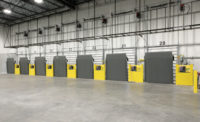10 tips for designing hurricane-resistant distribution facilities

Distribution centers play a critical role in ensuring that the public has access to food in the immediate aftermath of a major storm, and in the weeks of rescue and recovery that follow. Knowing this, many food distributors keep between 2-4 weeks of extra stock.
But, what happens if the distribution center itself is in the path of destruction? How can designers and owners work together to ensure that this critical link in the logistics chain stays intact and performs?
These tips will help distribution-center owners understand and respond to the design challenges associated with severe weather.
- Verify footings can resist wind uplift loads.
Foundation footers are the first building element that contacts the soil, spreading the weight of the structure across a large footprint. For distribution facilities in most parts of the country, footings are sized for gravity loads due to building weight and snow loads. In high-wind regions, a footing designed for gravity loads may be inadequate to resist wind uplift loads.
Increasing footing sizes and/or burying them deeper within the subgrade provides sufficient weight to overcome the high uplift forces a hurricane can generate. Other measures used to resist wind uplift and overturning loads include using larger, longer column anchor bolts and strengthening anchors used for walls, mechanical, refrigeration and electrical equipment.
- Design the structure and connection detailing for lateral hurricane wind forces.
The high lateral wind loads associated with hurricane regions require close attention to the design of lateral load-resisting systems, including x-braces, moment frames, roof and floor deck diaphragms and shear walls. Properly anchoring exterior walls to structural framing is an area of special concern due to the high pressure and suction forces that occur, particularly at building edges and corners.
- Improve the roofing system to handle uplift loads.
Like an airplane wing, a roof generates lift when wind blows across it. During a hurricane, this creates uplift on the roofing membrane, causing it to balloon upward and allowing water into the building.
While there is no such thing as a hurricane-proof roof, there are ways to improve the roofing system’s ability to handle wind uplift. High-performance fastening systems are capable of keeping panels, insulation and roofing pinned to the building during wind events.
- Use impact-resistant door and window openings to handle debris.
Distribution centers tend to have few windows, but every opening in a building is a potential point of failure, including doors, skylights, vents and glazing. When an opening is compromised by, say, a flying tree, forces on the structural system increase dramatically due to internal pressure.
Impact-resistant openings can help guard against projectiles. Impact-resistant doors are tested in a wind chamber, shot by 2x4s and put through the paces to ensure stability. Impact-resistant glazing systems are expensive, but offer a level of confidence while still allowing natural light in and views out.
- Protect insulated metal panels building envelopes.
The building envelope is another area of concern for distribution centers in the path of a hurricane. With enough force, a flying projectile can go through a sheet-metal wall like a nail through a tire. One solution is to add a concrete panel system around the structure for added protection. This gives the distribution center impact resistance, allowing it to weather a major storm and keep services running.
- Supersize backup generators and fuel stores.
After a storm, power can be out for days, making fuel storage and generator capacity a mission-critical reality. The backup generator must be capable of meeting the distribution center’s power needs for as long as it takes for the upstream utilities to get back online.
During Hurricane Irma, Publix, Lakeland, Fla., was able to run its distribution centers for days on backup power thanks to multiple generators and a hurricane-resistant fuel bunker capable of storing a week’s worth of fuel.
- Design the refrigeration system so that it can safely shut on and off.
Large cold storage facilities often come with cooling systems that store thousands of pounds of ammonia in pipes throughout the facility. During a hurricane, these systems must be turned off to avoid damage and turned back on after the threat has passed. This is not as simple as flipping a switch, and requires careful facility planning to accommodate.
Rather than using a small number of large compressors, it’s wise to use a large number of different sized compressors and a control system to slowly stop the flow of ammonia and then slowly bring it back online once the storm has passed. This allows the system to be turned on and off without damage to its components.
- Select and engineer a site with flooding in mind.
Site selection is one of the most critical parts of planning a distribution center – doubly so in a flood zone. Depending on the extent of flooding, cleanup may require the replacement of all on-floor equipment, stock, electrical gear and air handlers. If the distribution center has a product line, disinfection from mold is a huge undertaking.
When choosing a site, it’s important to consult flood-plain maps and consider elevation and drainage. Civil engineering solutions such as grading, berms, ditches and porous surfaces can make or break a site during a flood event.
- Elevate the important stuff.
In the event of an unstoppable flood, losses can be kept manageable by elevating the most critical components of the mechanical and electrical systems. Because most distribution centers are 1 story, choices may be limited to the mezzanine and the roof. While space on the mezzanine is at a premium, it may be preferable to the roof, where wind and rain can cause damage. Through careful space planning, mechanical, electrical and plumbing equipment can share space with offices on the mezzanine without infringing on product-rack space.
Salt water and live electrical parts are a recipe for disaster, and the damage caused by electrical gear exploding dramatically increases recovery time. Electrical panels should be fed from above and designed to be disconnected when water encroaches. Being able to clean or quickly replace distribution panels speeds the recovery time after the storm. Connections must be watertight and continuous, and conductors should be elevated to avoid disrupting the entire electrical distribution system.
- Make everything washable.
Finally, it’s important to design interiors that can bounce back from a flood relatively quickly. Lower-floor spaces must be easily stripped, cleaned and put back in service quickly. This means using washable materials such as concrete, tile and stainless steel rather than carpet and sheetrock.
The above tips won’t guarantee that your distribution center will weather the storm, but they will ensure that the damage is minimized. For your customers, this means more consistent access to food and other goods during their time of greatest need.
Looking for a reprint of this article?
From high-res PDFs to custom plaques, order your copy today!






